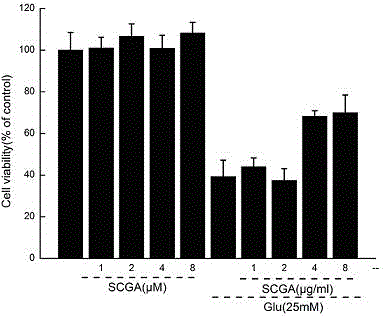Application of sparassis crispa polysaccharide extracts to preparing medicines for treating neurodegenerative diseases
A technology of neurodegeneration and polysaccharide extraction, which is applied in the field of medicine, can solve the problems of public use and loss of drugs with no obvious curative effect, and achieve obvious effects of neuroprotection, memory improvement and remarkable effect
- Summary
- Abstract
- Description
- Claims
- Application Information
AI Technical Summary
Problems solved by technology
Method used
Image
Examples
Embodiment 1
[0015] Preparation of Hydrangea Polysaccharide Extract
[0016] Hydrangea SC031 was passed through a fermenter to obtain a fermented liquid, centrifuged at 4000-5000 rpm for 5-10 minutes, the supernatant was discarded, and the precipitate was freeze-dried to obtain hydrangea toadstool powder, which was extracted with 100 times the amount of hot water at 80°C Twice, 3 hours each time, filter and recover the extract, concentrate to a relative density of 1.15-1.20 at room temperature, and vacuum dry to obtain the hydrangea polysaccharide extract.
Embodiment 2
[0018] Protective effect of hydrangea SC031 polysaccharide extract on differentiated PC12 cells damaged by neurotoxin 6-OHDA
[0019] In the present invention, the cell survival rate is used as an index, and the result detected by the MTT method reflects the degree of toxicity of hydrangea polysaccharide extract against neurotoxin 6-OHDA, so as to illustrate its neuroprotective effect.
[0020] Take the PC12 cells in the logarithmic growth phase, dilute them into a cell suspension of 3*105 cells / ml with complete medium, inoculate 100 μl per well in a 96-well plate, and culture them in a 37°C, 5% CO2 incubator for 24 hours. Remove the medium, add 100 μl hydrangea polysaccharide extract solution (final concentration 4 μg / ml, 8 μg / ml, prepared from the basic medium as a solvent), add 100 μl basic medium to the model group and control group, 4 in each group Repeat hole. After drug pretreatment for 3 hours, 6-OHDA (final concentration: 100 μmol / l) was added to the administration g...
Embodiment 3
[0024] The above example 1 Hydrangea SC031 polysaccharide extract sample repairs the abnormal function of mitochondria in PC12 cells caused by neurotoxin 6-OHDA
[0025] Molecular probe JC-1 can be used to measure mitochondrial membrane potential. JC-1 is a lipophilic cationic dye that selectively enters mitochondria. Can reversibly change from green to red when membrane potential is raised (Cossarizza et al. 1993). In healthy cells, the mitochondrial membrane potential is high, and JC-1 can spontaneously form complexes called J-aggregates with strong red fluorescence. On the other hand, in apoptotic or unhealthy cells with low mitochondrial membrane potential, JC-1 is still in a monomolecular configuration, and it can only show green fluorescence (Cossarizza et al. 1993).
[0026] Take the PC12 cells in the logarithmic growth phase, dilute them into a cell suspension of 3*105 cells / ml with complete medium, inoculate 1 ml per well in a 6-well plate, and culture them in a 37°...
PUM
 Login to View More
Login to View More Abstract
Description
Claims
Application Information
 Login to View More
Login to View More - R&D
- Intellectual Property
- Life Sciences
- Materials
- Tech Scout
- Unparalleled Data Quality
- Higher Quality Content
- 60% Fewer Hallucinations
Browse by: Latest US Patents, China's latest patents, Technical Efficacy Thesaurus, Application Domain, Technology Topic, Popular Technical Reports.
© 2025 PatSnap. All rights reserved.Legal|Privacy policy|Modern Slavery Act Transparency Statement|Sitemap|About US| Contact US: help@patsnap.com


